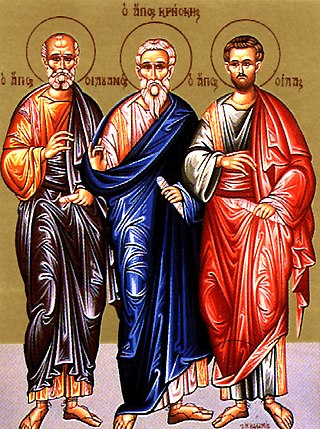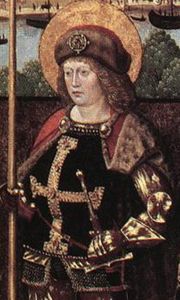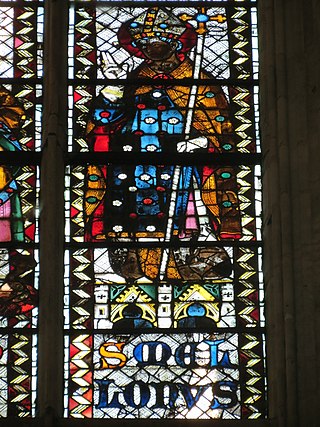
Saint Nicasius of Rouen (French : Nicaise de Rouen; d. perhaps c. 260), often known as the Apostle of the Vexin, was a 3rd-century saint and martyr in Gaul. He is sometimes considered the first Bishop of Rouen.

Saint Nicasius of Rouen (French : Nicaise de Rouen; d. perhaps c. 260), often known as the Apostle of the Vexin, was a 3rd-century saint and martyr in Gaul. He is sometimes considered the first Bishop of Rouen.
While the Liber Eburneus of the cathedral of Rouen indicates St. Mellon as first Bishop of Rouen, the Liber Niger of St. Ouen and the episcopal lists dating from the twelfth century mention the episcopate of a certain Nicasius (Nicaise) as antedating that of St. Mellon. [1]
According to tradition, Nicasius was an associate of Denis of Paris. Confusion of this Denis with Dionysius the Areopagite led some to suppose that Nicasius was born in Athens. [2]
According to Hilduin of Saint-Denis, Nicasius evangelized the Vexin. He spent a year at Mousseaux and evangelized Rolleboise nearby. He performed several miracles and evangelized numerous places along the Seine (among them Conflans, Andrésy, Triel, Vaux, Meulan, Mantes and La Roche-Guyon). His companion, Quirinus, is said to have delivered the residents of Pontoise from a dragon. [2]
Nicasius and his two companions were beheaded on the banks of the Epte in Gasny [3] before reaching Rouen. [1] He was believed to have been buried in Gasny. At the beginning of the ninth century the relics of Quirinus were translated to Malmedy Abbey. [4]
Saint Mellon, possibly the next bishop, is traditionally said to be a disciple of Nicasius.
Nicasius is a saint, listed in the Roman Martyrology on 11 October, his feast day. [5] He is represented in art as a cephalophore, referring to his martyrdom, and also as a bishop.

Pope Alexander I was the bishop of Rome from about 108/109 to 116/119. Some believe he suffered martyrdom under the Roman emperor Trajan or Hadrian.

Pope Telesphorus was the bishop of Rome from c. 126 to his death c. 137, during the reigns of Roman Emperors Hadrian and Antoninus Pius.

Pope Anacletus, also known as Cletus, was the bishop of Rome, following Peter and Linus. Anacletus served between c. AD 80 and his death, c. AD 92. Cletus was a Roman who, during his tenure as pope, ordained a number of priests and is traditionally credited with setting up about twenty-five parishes in Rome. Although the precise dates of his pontificate are uncertain, he "...died a martyr, perhaps about 91". Cletus is mentioned in the Roman Canon of the mass; his feast day is April 26.

Pope Marcellinus was the bishop of Rome from 30 June 296 to his death in 304. A historical accusation was levelled at him by some sources to the effect that he might have renounced Christianity during Emperor Diocletian's persecution of Christians before repenting afterwards, which would explain why he is omitted from lists of martyrs. The accusation is rejected, among others, by Augustine of Hippo. He is today venerated as a saint in the Catholic Church and in the Serbian Orthodox Church.

Crescens was an individual who appears in the New Testament. He is traditionally considered one of the 72 disciples sent out by Jesus in Luke 10. He was a missionary in Galatia and became a companion of Paul. The name 'Crescens' is the present-active participle of the Latin word crescere, and means 'increasing'.

The Martyrology of Usuard is a work by Usuard, a monk of the Benedictine abbey of Saint-Germain-des-Prés. The prologue is dedicated to Charles the Bald indicating that it was undertaken at that monarch's instigation. It was apparently written shortly before the author's death in 875. The martyrology enjoyed consistent success throughout the Middle Ages, as evidenced by numerous surviving manuscripts. This martyrology synthesizes elements of the old Martyrologium Hieronymianum, the martyrology of Ado of Vienne, and an enhanced version of that of Bede, attributed to the archdeacon Florus of Lyon. It contains eleven hundred saints' lives. The martyrology is a compilation upon which the later Roman Martyrology depended closely until the twentieth century; it remained throughout the Middle Ages the most famous document of its kind. It is preserved to us in innumerable manuscripts, of which Henri Quentin gives a partial list.

Gereon of Cologne, who may have been a soldier, was martyred at Cologne by beheading, probably in the early 4th century.
There are several saints named Rufus, of which the Roman Martyrology records ten; historical mention is made of the following ones, which have liturgical feasts:

The Archdiocese of Sens and Auxerre is a Latin archdiocese of the Catholic Church in France. The archdiocese comprises the department of Yonne, which is in the region of Burgundy. Traditionally established in sub-apostolic times, the diocese as metropolis of Quarta Lugdunensis subsequently achieved metropolitical status. For a time, the archbishop of Sens held the title "primate of the Gauls and Germania". Until 1622, the metropolitan archdiocese numbered seven suffragan (subordinate) dioceses: the dioceses of Chartres, Auxerre, Meaux, Paris, Orléans, Nevers and Troyes, which inspired the acronym CAMPONT. The Diocese of Bethléem at Clamecy was also dependent on the metropolitan see of Sens. On December 8, 2002, as part of a general reorganization of the dioceses of France undertaken, at least in part, to respond to demographic changes, the Archdiocese of Sens-Auxerre ceased to have metropolitan rank and became a suffragan of the Archdiocese of Dijon, which became the centre of a new ecclesiastical province for the Burgundy administrative region.

A cephalophore is a saint who is generally depicted carrying their severed head. In Christian art, this was usually meant to signify that the subject in question had been martyred by beheading. Depicting the requisite halo in this circumstance offers a unique challenge for the artist: some put the halo where the head used to be, and others have the saint carrying the halo along with the head. Associated legends often tell of the saint standing and carrying their head after the beheading.

Saint Nicasius of Reims was a Bishop of Reims. He founded the first Reims Cathedral and is the patron saint of smallpox victims.

Nicasius of Die was a 4th-century bishop from Gaul, present-day France. As Bishop of Die he is notable to history as one of only five Catholic bishops from the Western part of the Roman Empire who attended the First Council of Nicaea in 325.
Nicasius was a Roman cognomen, whose variants include Nicasio, Nicaise, and Necaise. It can refer to:

Nicasius, Quirinus, Scubiculus, and Pientia were venerated as martyrs and saints. Their feast day is 11 October. Their historicity is uncertain, and "no trustworthy historical reports of [them] exist."

Saint Mellonius (229-314) was an early 4th-century Bishop of Rotomagus in the Roman province of Secunda Provincia Lugdunensis. He is known only from a 17th-century 'Life' of little historical value, meaning the historicity of his existence is uncertain.
Aphrodisius is a saint associated with the diocese of Béziers, in Languedoc, Southern France.
Basilides, Cyrinus, Nabor and Nazarius are saints of the Catholic Church, mentioned in the Martyrology of Bede and earlier editions of the Roman Martyrology for 12 June as four Roman martyrs who suffered death under Diocletian.

Quirinus of Neuss, sometimes called Quirinus of Rome is venerated as a martyr and saint of the Catholic and Eastern Orthodox churches. His cult was centred at Neuss in Germany, though he was a Roman martyr.

Primate of Normandy is a Catholic title borne by the Metropolitan Archbishop of Rouen.